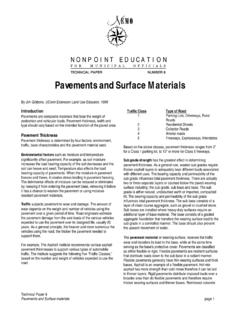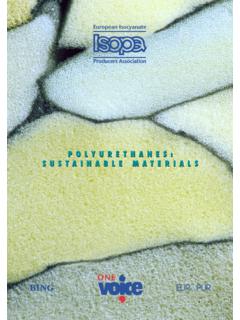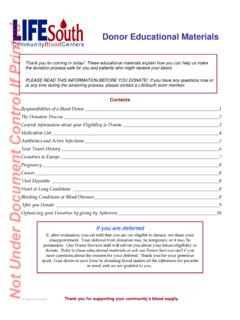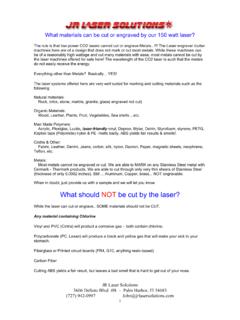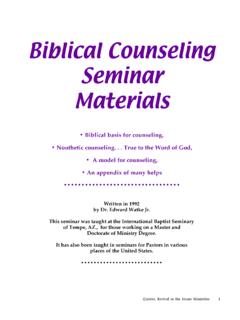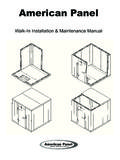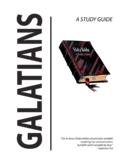Transcription of Wind Turbine - Materials and Manufacturing Fact Sheet
1 Wind Turbine Materials and Manufacturing Fact Sheet August 29, 2001. Wind Turbine - Materials and Manufacturing Fact Sheet Prepared for the Office of Industrial Technologies, US Department of Energy By Princeton Energy Resources International, LLC. Dan Ancona and Jim McVeigh Recognition of the value of wind energy as a low cost, clean source for electricity is creating major new business opportunities for Manufacturing and Materials innovation. Worldwide growth in wind generation since 1994 has been 30% or higher annually.
2 The cost of energy from large wind power plants has declined to less than $ at good wind sites. By the end of 2000, the global capacity had passed 17,600 megawatts (MW) [See reference 1], and in the United States alone, more than 1,800 MW of new installations should be completed this year [2, 3]. The combined sales of large wind power plants and small turbines for distributed generation is now $4-5 billion annually worldwide and growing. Small turbines (less than 100 kW each) are being produced for the growing distributed generation and off-grid markets.
3 Grid-connected wind power plants typically employ hundreds of 1 to 2 MW turbines today and larger, 3 to 5. MW machines, with 100-meter (m) (110 yards - longer than a football field) or greater rotors are being developed. The wind Turbine Manufacturing business has grown from a cottage industry, with hand-built subsystems, to sales warranting large-scale production operations. Parts of a Wind Turbine Wind turbines come in many sizes and configurations and are built from wide range of Materials . In simple terms, a wind Turbine consists of a rotor that has wing shaped blades attached to a hub; a nacelle that houses a drivetrain consisting of a gearbox, connecting shafts, support bearings, the generator, plus other machinery; a tower; and ground-mounted electrical equipment.
4 The wing shaped blades on the rotor actually harvest the energy in the wind stream. The rotor converts the kinetic energy in the wind to rotational energy transmitted through the drivetrain to the generator. Generated electricity can be connected directly to the load or feed to the utility grid [4]. The weight and cost of the Turbine is Wind Turbine Nomenclature the key to making wind energy Princeton Energy Resources International, LLC 1. Wind Turbine Materials and Manufacturing Fact Sheet August 29, 2001.
5 Competitive with other power sources, because research programs have significantly improved the efficiency of the rotor and maximized the energy capture of the machine. The real opportunity today is through better, low cost Materials and though high volume production, while ensuring the reliability is maintained. The typical weight and cost of the primary Turbine components today are shown in Table 1. In addition there are foundations and conventional ground-mounted systems, including transformers, switching and other power equipment.
6 There appear to be several areas where Table 1. Turbine Component Weight and Cost technological progress and cost reduction are needed. Turbine Component % of % of subsystem costs are generally evenly Machine Machine split between rotor, nacelle, drivetrain Weight Cost [5]. power systems, and the tower. There is Rotor 10-14 20-30. no single component that dominates Turbine cost. The rotor is the highest Nacelle and machinery, less 25-40 25. cost item on most machines and must Gearbox and 5-15 10-15.
7 Be the most reliable. Towers are drivetrain normally the heaviest component and Generator systems 2-6 5-15. could benefit from weight reduction, but lightening the rotor or tower-top Weight on Top of Tower 35-50 N/A. weight has a multiplier effect Tower 30-65 10-25. throughout the system including the foundation. Expected Technology Evolution The components of turbines are changing as the technology improves and evolves. There is a trend toward lighter weight systems. Light weight, low cost Materials are especially important in blades and towers for several reasons.
8 First the weight of the blades and rotor is multiplied through out the machine. The tower weight is key because it is typically 60%. of the weight of the Turbine above the foundation, due to the fact that sophisticated light- weight, high-strength Materials are often too costly to justify their use. Wind Turbine Technology Evolution Princeton Energy Resources International, LLC 2. Wind Turbine Materials and Manufacturing Fact Sheet August 29, 2001. Another technology shift is occurring in the drive train.
9 In some cases the gearbox is being eliminated by employing variable speed generators and solid state electronic converters that produce utility quality alternating current (AC) power. This trend began in small machines and is now being incorporated in Turbine sizes from 100 kW to 3 MW. Other trends in wind Turbine technology are discussed in detail in the Renewable Energy Technology Characterizations published by the Electric Power Research Institute (EPRI) [5] with DOE support. Market and Turbine Component Materials Data To estimate the quantities and types Table 2.
10 Turbine Models Used in Current and Future of Materials used in wind turbines, a Materials Usage Estimates database was compiled from a variety of industrial, DOE laboratory Turbine Make Rated Power (kW). and existing PERI sources. Much of Southwest Windpower , the wind Turbine and component Bergey , 10. characteristics and weight data came Atlantic Orient Corp. 50. from the DOE, Wind Partnerships for Northern Power Systems 100. Advanced Technologies Enercon 500, 850. (WindPACT) program database Micon 600, 900.
